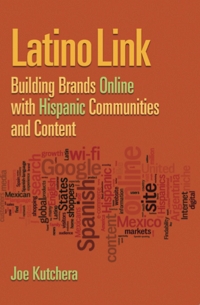This article originally appeared on MediaPost and is an early preview of Latino Link: Building brands online with Hispanic communities and content from Paramount Books.
In a recent report from Pew Hispanic Center, U.S. Hispanics represented over 50% of the U.S. population growth since 2000. In our current economic climate, one would think that that be the kind of growth that marketers would aggressively seek out. While Hispanic media investment overall has grown considerably, especially television, the online ad segment has under-indexed relative to general market online spending even though the U.S. Hispanic audience is more open to brand suggestions and advertising messages, as shown in a recent eMarketer report.
Will Hispanic marketers shift their investments towards online as the general market has and as new tools and targeting technologies improve? Some leading agencies, online publishers, and technology companies have met marketers’ needs with new marketing approaches for this growing audience.
This article brings together experts in online marketing to U.S. Hispanics to share their insights on targeting options such as geo-targeting, behavioral, contextual, search, and others to more effectively segment and reach the U.S. Hispanic audience with multiple levels of acculturation across a fragmented online media marketplace.
Geo-Targeting
Geo-targeting (also known as IP targeting) to specific countries, states, or DMAs is popular in segmenting Hispanics from different countries of origin or segmenting different countries across Latin America. Kristina Canada, Media Director at Media8, says “We focus on aggressive IP targeting to reach our desired audiences. This strategy can come to play when reaching U.S. Hispanics via U.S. IP targeting on best-in-class Latin American Spanish-language sites. Or, we use it in reaching key Latin American audiences via IP targeting on U.S. Spanish-language sites that have substantial traffic coming from Latin America.”
Behavioral targeting
Behavioral targeting can provide effective results for marketers looking to reach a large number of online consumers while aggregating consumer ad response data and optimizing results. Gail Galuppo, CMO of Western Union, says, “Behavioral targeting is our most successful strategy for reaching online Hispanic consumers. We also use broad-reach and niche, country-of-origin news, video and sports sites to reach consumers who are likely to send money home.”
Dave Morgan, founder of behavioral targeting network Tacoda (now part of AOL) and currently Chairman of The Tennis Company, says “I think that behavioral targeting will play an important role in targeting bi-lingual Hispanics. The biggest hurdle today is not the ability of the technology to deliver a better ad, but the lack of market demand. While Hispanic advertising is a popular topic for the industry to talk about and write about, there is still very little money spent on it online.”
Contextual Targeting
This type of targeting enables clients to place banner or text ads alongside relevant content. Marla Skiko, SVP at SMG Multicultural, says, “We have utilized contextual targeting to seek Moms in cooking/family/entertaining content across a variety of sites and channels. Where applicable, we created a behavioral segmentation for “avid Latina chefs” to reach those Moms who really enjoy cooking and prepare more than the average number of meals per week at home to more closely match our message with our core intended user. Based on the performance of the behaviorally targeted placements, we have created other specifically designed behavioral segmentations for several other clients as we see a direct correlation between performance and tight match between message and media environment.”
Search
Ask experts from Google or Yahoo and they will suggest buying keywords in both English and Spanish for reaching both English-dominant and Spanish-dominant U.S. Hispanics. This also facilitates easy switching between the two languages for second-generation Hispanics who are comfortable with both languages.
In a presentation at ad:tech Chicago earlier this year, Google presented “AdWords and the U.S. Hispanic Market” in which it offered suggestions on how to best use search to reach U.S. Hispanics.
• U.S. Hispanics search in both languages so a mixture of both languages is key
• Try different creative in different DMAs
• Use a Spanish-language landing page for the Spanish keywords just as you do for English-language keywords
• Include accented and unaccented keywords
• Experiment with Spanish variations of words from different parts of Latin America
• Try using elements of Spanish and English in the same creative
Content Category Targeting
Just as marketers buy media in specific magazine categories or brands, they can also buy online media across specific content sites or types. Marcelo Salup, VP Media and Strategic Planning, at Siboney USA, says, “The single most successful targeting I’ve ever found is through site type. For Kingston Technology we bought lots of computer sites (for the flash drives), music sites (for the micro cards), but the most successful site ever was Universia.Net, a site aimed squarely at university students who needed the transportability of the flash drives and the absolute 100% integrity guarantee.”
Creative Re-Targeting
As an extension of behavioral targeting, this type of targeting delivers a cookie to users who have been served an ad, typically on an ad network. That user is then retargeted with the same creative messaging as they travel across sites on the ad network, essentially “following” a user based upon their proven media consumption habits, thereby delivering a more relevant advertisement.
Spanish-language Browser Targeting
Some marketers utilize more advanced approaches such as Spanish-language browser targeting, for example, within ad networks in order to reach Spanish-dominant users who feel more comfortable with defaulting their Internet browsers to their native language. Kristina Canada of Media8 found that these users make up about 15% of the U.S. Hispanic online population.
Conclusions
Rafael Urbina, CEO of Batanga, summarizes the options for marketers. “There is no one way to reach U.S. Hispanics online, similar to the general market. The most successful campaigns are those that combine the right mix of tools to properly segment and reach their target. The key to reaching U.S. Hispanics, however, is to remember that the context is just as important as the target. Not only should your messaging be culturally relevant, but so, too, the environments in which they are placed.”
While many of the above targeting strategies provide incredible opportunities for marketers and agencies to better understand their target markets, some challenges still lie ahead.
Most notably, these targeting methods generate enormous amounts of data, especially when used in combination with one another. The agency, publisher and/or technology companies that figure out how to manage and best utilize the various types of targeting and fountains of data will establish themselves as leaders in helping their clients make smarter, quicker and more effective marketing plans.
In addition, these technologies have evolved to drive better results for clients while also providing media consumers with more relevant, useful information from advertisers and keeping online media free. With the potential for civil liberty issues, the IAB encourages online media companies to follow its Privacy Principles. Mike Zaneis, VP of Public Policy, Interactive Advertising Bureau, says “Meeting our consumers’ privacy expectations is key to the success and viability of this ecosystem. The IAB is working with its member companies and partner trade associations to further build upon these privacy principles and to create a privacy self regulatory program that covers every segment of the industry.”
![Reblog this post [with Zemanta]](https://img.zemanta.com/reblog_e.png?x-id=62cf7c8a-0500-4a18-8f2e-6623c72790f8)






